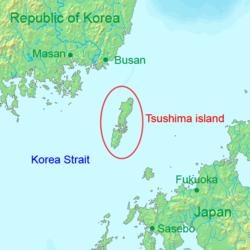
January 7, 2010
Rare Japanese Wildcat Rediscovered
By Brent Swancer

Map of Tsushima Island.
The Year 2009 proved to be a promising one for a rare type of Japanese wildcat, when a living specimen of Tsushima leopard cat was discovered in an area where the animals had long been feared extinct.
The Tsushima leopard cat (Prionailurus bengalensis euptilura) is an isolated subspecies of Asian leopard cat found only on the small island of Tsushima, Japan. The 273.6 sq mile island is located in the Korean Strait, 49.5 km (31 miles) from the Korean peninsula and 138 km (86 miles) from Japan’s Kyushu Island. The island’s population is 40,000. Tsushima leopard cats are similar in size and appearance to housecats, which they are often mistaken for. They are one of two endemic species of wildcat native to Japan, the other being the Iriomote wildcat found on Iriomote Island.
Tsushima Island is divided by artificial waterways into two separate islands; Kamijima, and Shimojima. The larger and more sparsely populated upper island, Kamijima, is home to an estimated 80 to 110 of the endangered wildcats. Until recently, it was thought that Kamijima was the sole remaining habitat of Tsushima leopard cats. The more populous lower island, Shimojima, is more heavily developed and it was thought for decades that the leopard cats had disappeared from there. The last confirmed physical specimen of Tsushima leopard cat on the lower island was a dead cat found on a roadway in 1984. No more cats were seen on Shimojima until 2007, when a trail cam snapped a picture of one, marking the first confirmation of cats in the area in over two decades.


The trail cam photos of a Tsushima cat (Prionailurus bengalensis euptilura) captured in 2007.
The recent discovery of a live leopard cat on Tsushima’s lower island marks the first physical evidence of wildcats living here since 1984. The recently found cat was a 1,130 gram juvenile male, which has been estimated to have been born just this past spring. The cat, which was suffering from severe malnourishment, was found on a company property in the town of Izuhara. The cat will be nursed back to health by authorities.
Along with the related Iriomote wildcat, Tsushima leopard cats are important animals of discovery within cryptozoology. The two types of cat were not confirmed by science until the 1960s. Both varieties of cat are critically endangered and rarely seen, with numbers hovering around only a hundred individuals. The cats are threatened by habitat destruction and roads that bisect their territory. Road kills remain the most pressing threat to the animals’ continuing survival. On Tsushima’s upper island of Kamijima, 42 of the leopard cats have been killed on roadways since 1991.
Japanese biologists are hoping that this latest discovery of a live Tsushima leopard cat on the lower island is an indicator that more will be found, and that a breeding population may even still exist here.
About Loren Coleman
Loren Coleman is one of the world’s leading cryptozoologists, some say “the” leading living cryptozoologist. Certainly, he is acknowledged as the current living American researcher and writer who has most popularized cryptozoology in the late 20th and early 21st centuries.
Starting his fieldwork and investigations in 1960, after traveling and trekking extensively in pursuit of cryptozoological mysteries, Coleman began writing to share his experiences in 1969. An honorary member of Ivan T. Sanderson’s Society for the Investigation of the Unexplained in the 1970s, Coleman has been bestowed with similar honorary memberships of the North Idaho College Cryptozoology Club in 1983, and in subsequent years, that of the British Columbia Scientific Cryptozoology Club, CryptoSafari International, and other international organizations. He was also a Life Member and Benefactor of the International Society of Cryptozoology (now-defunct).
Loren Coleman’s daily blog, as a member of the Cryptomundo Team, served as an ongoing avenue of communication for the ever-growing body of cryptozoo news from 2005 through 2013. He returned as an infrequent contributor beginning Halloween week of 2015.
Coleman is the founder in 2003, and current director of the International Cryptozoology Museum in Portland, Maine.
Filed under Cryptomundo Exclusive, CryptoZoo News, Mystery Cats